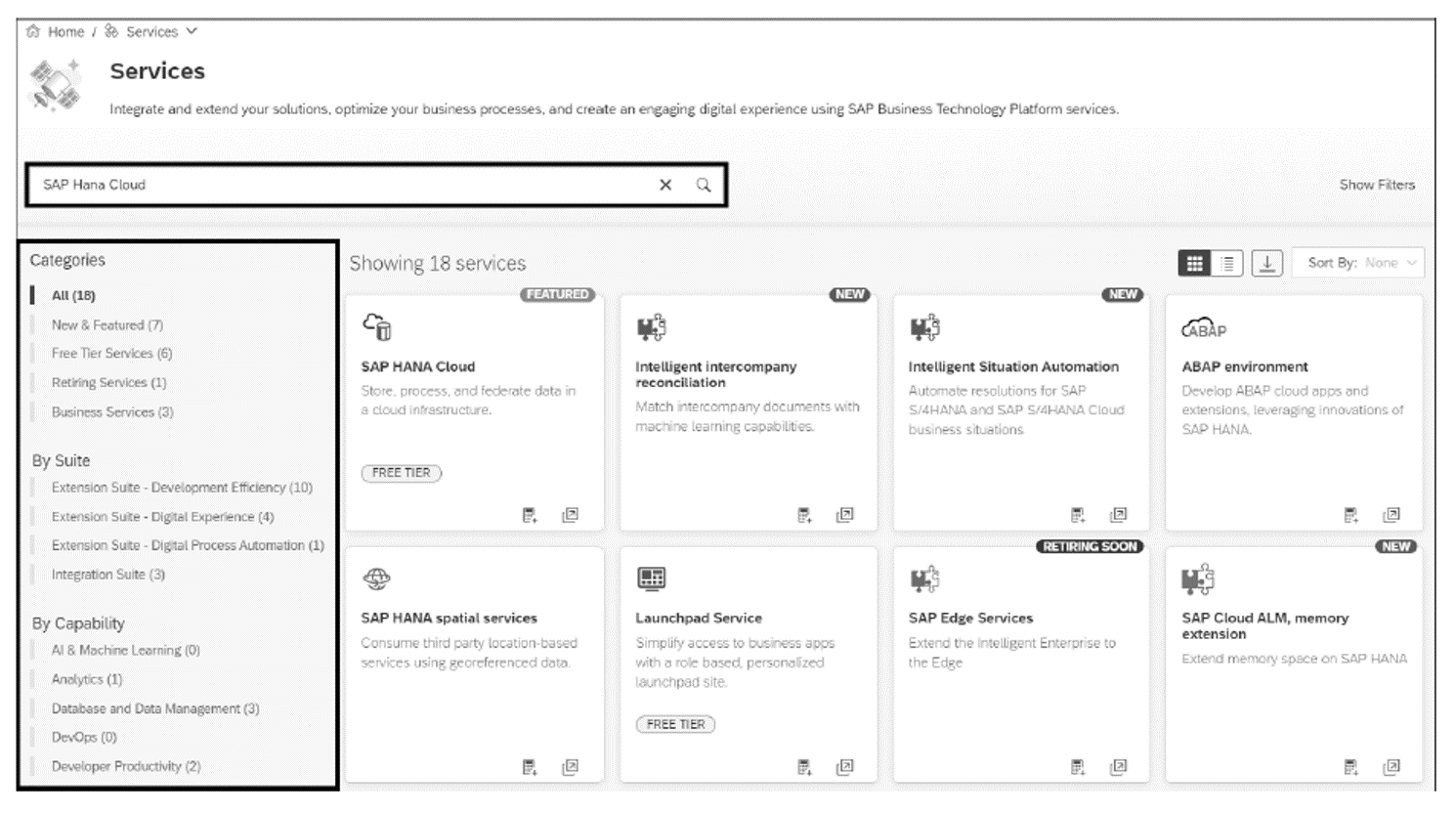

SAP Business Technology Platform (SAP BTP) unifies data management, analytics, application development, integration, automation, and AI into a single cloud platform. It helps businesses turn data into actionable insight, modernize application landscapes, and embrace clean core strategies using extensible, modular services.
Table of Contents
While SAP BTP as an offering is relatively new, it consists of solutions that have been around for years, and portions of the platform’s architecture go back quite a ways. For example, the application development and integration pillar of SAP BTP (more on this pillar below) can trace its lineage back to SAP HANA Cloud Platform in the early 2010s.
SAP BTP was first introduced in 2021 when SAP decided to package multiple services and products into one platform that businesses could use to make business decisions. Their reasoning was, because there are so many different parts to an intelligent enterprise, it made sense for them all to be offered by one vendor, rather than having to integrate disparate systems into a central core. As part of this announcement, the SAP Cloud Platform brand was sunsetted and SAP Cloud Platform’s functionality was rolled into SAP BTP.
Throughout 2021 and into 2022, SAP bolstered SAP BTP with different acquisitions. For example, in July 2022, SAP announced it was purchasing Askdata to improve its AI-related capabilities in SAP BTP, particularly regarding natural language searches.
The latest features of SAP BTP include the release of SAP Build Code and SAP Build Apps (formerly SAP AppGyver) for low-code/no-code development, enhancements to AI capabilities, and the introduction of SAP Graph. You can always see what’s new by checking out the SAP Discovery Center page.
There are two environments of SAP BTP, which have a common set of services—but also services that are unique to each of the two environments.
The first, called SAP BTP, Neo environment, is focused on cloud capabilities available from SAP‘s own data centers and allows users to connect to SAP ERP solutions. Development languages available in the Neo runtime are limited to Java, HTML5, and SAP HANA XS.
The second environment is the, SAP BTP, Cloud Foundry environment. This allows users to utilize any data center, not just SAP’s centers, and allows more extensibility options for developers and hyperscale vendors, such as Amazon Web Services, Google Cloud Platform, and Microsoft Azure. Developers can bring their own programming language to this environment, and multiple runtimes exist, including one for ABAP and Kyma.
SAP BTP is built upon a foundation of five pillars. Below explains each.

Data and analytics focuses on exploring data, looking for trends, and making actionable plans with the information you bring into the system.
Data management focuses on keeping track of and segmenting data so it’s accessible and usable by users. This includes storage, access, processing, integration, and more.
Data management and storage with SAP BTP can be accomplished in a number of ways, using databases such as SAP Adaptive Server Enterprise (ASE), SAP IQ, SAP HANA and SAP HANA Cloud, and SAP SQL Anywhere. Data can be cleansed, managed, and modeled with solutions such as SAP Data Intelligence, SAP Information Steward, SAP Data Quality Management, SAP PowerDesigner, SAP Information Lifecycle Management, SAP Landscape Transformation Replication Server, SAP Data Services, and SAP Master Data Governance.
SAP BTP allows users to perform both simple and advanced analytics with tools like SAP Analytics Cloud, SAP BusinessObjects BI, SAP Crystal solutions, SAP Data Warehouse Cloud, and SAP BW/4HANA. With the data and trends uncovered (often in real time), business operations can be better tailored to meet demand and run efficiently off a single source of truth.
Application development focuses on the creation of custom apps and extensions for specific business purposes. This is historically known as SAP Cloud Platform.
SAP BTP provides a set of both business and platform services that accelerate the development and innovation of cloud apps. As a language-agnostic platform, developers can utilize any one of a handful of programming languages, including ABAP, Java, Node.js, Ruby, Go, Python, PHP, and Groovy. DevOps are available to developers looking to improve the relationship and cooperation between developers and operations staff.
SAP BTP apps and services can be run alongside existing on-premise solutions by utilizing the SAP Integration Suite to facilitate information exchange.
Integration focuses on the pairing of SAP BTP with other SAP solutions. SAP BTP has services that support all possible integration needs in an organization. You can seamlessly integrate SAP and non-SAP solutions both on-premise and in the cloud while securely connecting applications, processes, and people. Out-of-the-box content that includes integration packs, application programming interfaces (APIs), business events, and connectors is available and ready to use on day one.
Automation focuses on removing the need for human input for predictable, mundane, and repetitive tasks. SAP Build Process Automation combines workflow management to help create forms, manage decision logic, and build, adapt, and organize process flows with simple drag-and-drop functionalities. Robotic process automation (RPA) automates human tasks that can be attended or unattended so people can support the task or have it run handsfree. Prebuilt content and connectors for SAP and non-SAP solutions help you get started quickly.
Artificial intelligence (AI) focuses on using tools that dive deep into existing pools of data for analysis, business insight, and content generation, and streamline business processes to free up time to work on other projects. AI and machine learning are getting embedded into everything—both simple and complex business processes. SAP provides several features in AI such as SAP Conversational AI. With the help of prebuilt AI models, you can realize self-learning programs and build intelligent business processes to realize your intelligent enterprise.
SAP BTP enables organizations to build, extend, and integrate applications in the cloud, with real-time analytics and automation. Below are common use cases:
Modernizing legacy applications with ABAP in the Cloud or SAP Build.
Creating dashboards and predictive insights using SAP Analytics Cloud and Data Warehouse Cloud.
Automating repetitive business processes with SAP Build Process Automation and SAP Intelligent RPA.
Developing mobile or low-code apps with SAP Build Apps or SAP Business Application Studio.
Integrating SAP and non-SAP applications with SAP Integration Suite.
Implementing clean core strategies by decoupling custom code from SAP S/4HANA using side-by-side extensibility.
Improving user experience by extending SAP Fiori-based apps across platforms.
As of September 2022, there are 97 services available as part of SAP BTP. While it isn’t possible to list them all (you can find the whole list here), there are a number that should be highlighted.

If you’re looking to get started with SAP BTP, there are a few ways to do so.
Those looking to trial SAP BTP can utilize a free tier that provides instant access to a production environment. While limitations exist in terms of what services you can use (currently, more than 30 services are available in the free tier) and how much capacity you can take up, this is a good way to get started with SAP BTP to see if it can help your business. If you decide to start paying for the platform, you can easily move the things you’ve already done into the paid option.
Those who are looking to try out new business processes with SAP BTP or are constrained by a budget can purchase access to the services that they need with the pay-as-you-go model. Using this option helps users by not having to commit a lot of money up front or meet minimum usage requirements.
The Cloud Platform Enterprise Agreement (CPEA) provides users with cloud credits that can be used to access any of the different services available with SAP BTP. Using the CPEA model is beneficial for those who need to use many different services, but who don’t necessarily need to use them all at the same time.
The SAP BTP subscription provides access to specific SAP BTP services (defined by a contract) for a fixed cost. Subscriptions range from one year to three years. Using the subscription model is good for those who have specific use cases and a specific budget in mind. If additional services are needed during the course of the subscription, they can be added on for an additional fee.
Feel you need more help learning SAP BTP? These books, blog posts, and videos will help.
Q: What is SAP BTP used for?
A: SAP BTP is used to develop, integrate, and extend SAP and non-SAP applications, enabling intelligent, cloud-first enterprise operations.
Q: What are the five pillars of SAP BTP?
A: They are: Data & Analytics, Application Development, Integration, Automation, and Artificial Intelligence.
Q: What is the difference between SAP BTP Neo and Cloud Foundry?
A: Neo runs only in SAP-managed data centers and supports fewer programming languages. Cloud Foundry is more open and supports deployment to hyperscalers like AWS and Azure.
Q: Is SAP BTP part of SAP S/4HANA?
A: No. SAP BTP is a separate platform that integrates with SAP S/4HANA to extend its capabilities without disrupting the core system.
Q: Is there a free version of SAP BTP?
A: Yes. SAP offers a free tier with access to over 30 services to test functionality before committing to a paid model.
In addition to the information laid out above, there are a handful of important SAP BTP terms you should also be familiar with. Here they are in list form:
Want to learn more about SAP BTP? Additional information can be found in the blog posts, books, and videos listed below and in this SAP BTP learning journey.
Learn more SAP from our official Learning Center.
And to continue learning even more about SAP BTP, sign up for our weekly blog recap here: